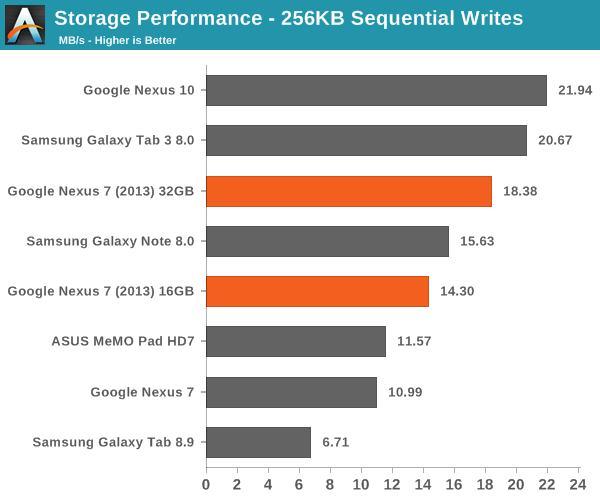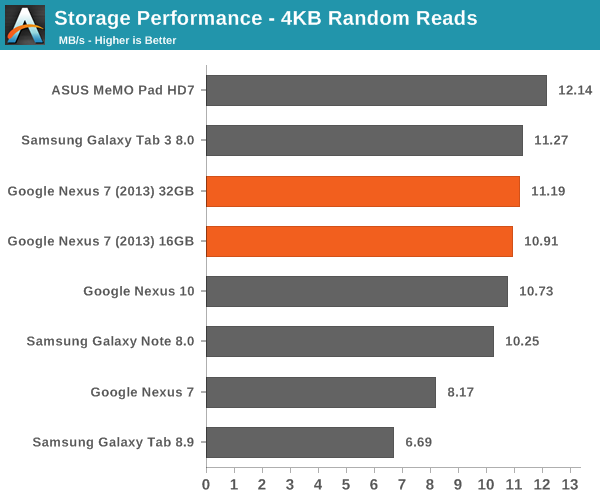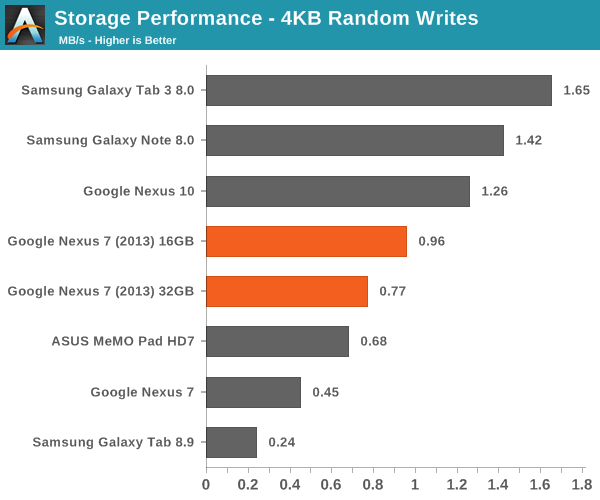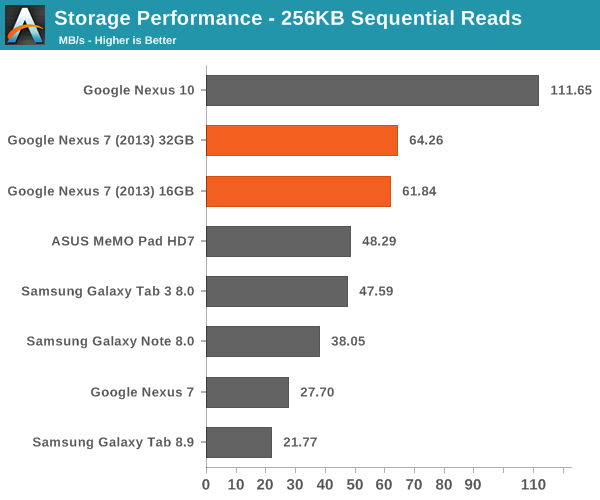The Nexus 7 (2013) Review
by Anand Lal Shimpi on August 22, 2013 6:00 PM ESTeMMC and FSTRIM
The new Nexus 7 obviously ships with the latest version of Android (4.3), which happens to add a major feature for keeping storage performance high: fstrim. Modern smartphones and tablets fundamentally use a very similar storage architecture to what we see in modern SSDs (solid state drives) in PCs. Instead of a drive featuring a discrete controller, DRAM and NAND flash, these ultra mobile devices typically feature one or two NAND devices with an integrated controller - typically eMMC. To keep costs (and power consumption) low there's also no DRAM cache, which definitely harms performance.
Since the underlying architectures are quite similar, the pitfalls are the same as well. The biggest issue? Performance when operating in a full or near-full state. With tons of files on your internal storage, the data structures that have to track all of those files and where they're located in NAND space get pretty complex, and traversing those structures takes a considerable amount of time. The part that many seem to forget is that once you delete a file in Android, it's not immediately removed from internal storage. The space is freed up in the OS, but the eMMC controller still tracks all of the data as valid bits. It's only when that data is overwritten that the controller knows the previous data didn't matter.
In other words, it's possible to have tons of free space on your internal storage, but have the drive appear full to the eMMC controller (and thus enjoy all of the terrible performance that goes along with it). To make matters worse, you never even have to fill your drive to get it into this state. In order to maintain even wear across all NAND cells (to extend the lifespan of the NAND flash), the eMMC controller will write to new/empty blocks in NAND as much as possible. Let's say you have 10GB of storage and Android writes 1GB of data to new addresses every month and deletes the previous 1GB each time. As long as the addresses being written to never overlap, your drive will be full in 10 months (from the eMMC controller's perspective) but Android will still report 9GB of free space.
fstrim establishes communication between the OS and the eMMC controller to address this problem - and it's enabled in Android 4.3.
Unlike TRIM on standard SSDs, FS_TRIM works more like the manual/scheduled TRIM tools from the early days of consumer SSDs. From Brian's original Android 4.3/TRIM article:
The Android framework will send out a “start idle maintenance window” event that the MountService listens for, and then invokes vold to fstrim filesystems when a few conditions have been met – the device hasn’t been touched for over an hour, no idle maintenance window event has been sent in 24 hours, and the device is either off-charger with 80% battery or on-charger with 30% battery. The goal is to have fstrim run roughly once every 24 hours if you’re in the habit of plugging the device in to charge every night.
Personally I feel like the rules are a bit excessive and I'd love to see us get to active TRIM on these devices, but I guess it's a bit too early for that. Basically if your device has enough charge and you're not using it, Android 4.3 will issue an fstrim command to the eMMC controller. The command passes along a list of all unallocated addresses in the filesystem, which the eMMC controller can then use to purge its logical to physical mapping table/list/datastructure. The process should complete relatively quickly as no new data has to be written, the controller just needs to do some cleanup of internal structures and add a bunch of addresses to the unused block pool. Keep in mind that this simply addresses the issue of your storage getting slower over time. fstrim does nothing to keep performance high if you actually fill your storage to capacity. Given how bad these eMMC solutions are, my recommendation is to try and keep at least 20% of your internal storage unused/as free space.
To showcase just how bad things can get I actually dusted off last year's Nexus 7 and treated it like an SSD. I first filled the device with sequential data, leaving only 300MB free. I then performed back to back random writes across the remaining free space and the performance reduction:
| Nexus 7 (2012) Storage Performance | ||||||
| Sequential Read | Sequential Write | Random Read | Random Write | |||
| New After Factory Reset | 25.18 MB/s | 10.63 MB/s | 7.08 MB/s | 0.45 MB/s | ||
| 1st Run After Fill | 22.25 MB/s | 1.21 MB/s | 7.62 MB/s | 0.14 MB/s | ||
| 2nd Run After Fill | 26.00 MB/s | 1.97 MB/s | 7.8 MB/s | 0.11 MB/s | ||
| 3rd Run After Fill | 24.57 MB/s | 3.18 MB/s | 7.96 MB/s | 0.16 MB/s | ||
| After ~24 hours Idle Time | 27.03 MB/s | 11.21 MB/s | 7.65 MB/s | 0.46 MB/s | ||
The columns to pay the most attention to are the write columns (read performance shouldn't change over time). Note that sequential write speed drops by almost an order of magnitude. This incredible drop in performance manifests itself as pauses or stutters. Even when you're just performing simple tasks on your tablet, there are usually tons of background operations going on (e.g. updating system logs). If you look at random write performance here, we see performance drop down to 0.11MB/s - or roughly 27 IO operations per second. If you have more than that amount of IO coming in at the same time, what you'll get are long pauses while the eMMC controller works through its IO queue. Although I didn't include it in the table above, I spent a full day torturing the eMMC on this Nexus 7 and managed to get random write performance as low as 0.02MB/s or 5 IOPS. Sequential write performance in that case was 0.81MB/s, equally disheartening. My point here is that worst case storage performance can get very bad, but looking at the last line of the table you see the incredible impact fstrim has on restoring performance.
I/fstrim ( 118): Starting fstrim work...
I/fstrim ( 118): Invoking FITRIM ioctl on /cache
I/fstrim ( 118): Trimmed 445079552 bytes on /cache
I/fstrim ( 118): Invoking FITRIM ioctl on /data
I/fstrim ( 118): Trimmed 13637656576 bytes on /data
I/fstrim ( 118): Finished fstrim work.
Anyone who had issues with their Nexus 7 slowing down over time will want to upgrade to Android 4.3. Those users considering upgrading to the new Nexus 7 should be fine thanks to fstrim. The only situation where you should see tremendous decrease in storage performance, resulting in IO latency enduced pausing/stuttering is if you physically fill the internal storage close to capacity. Again - my recommendation here is to try and leave at least 20% of your internal storage free. Note that this recommendation applies across Android and iOS.
With all of that out of the way, how does the eMMC solution in the new Nexus 7 stack up? Sequential read performance continues to be quite good for such a small/lower power device. Sequential write speed isn't terrible either. Even random read performance looks solid. It's random write performance that just needs work across the industry. We realistically need to probably be at 10x where we are today in random write performance, perhaps a bit lower if the storage makers can focus on IO consistency/minimum sustained IOPS.
Storage solutions in these tablets are often sourced from multiple vendors, and we can see dramatic differences in performance between them. Brian's review sample was a 32GB model, while the tablet I reviewed had 16GB. The two solutions performed pretty similarly, although my 16GB model did have appreciably better random write performance. Ultimately if you need the space, the 32GB model will be the better performer (you're better off using 45% of a 32GB model than 90% of a 16GB model).














202 Comments
View All Comments
vailr - Friday, August 23, 2013 - link
Won't Amazon be updating their Kindle Fire lineup pretty soon? Although not ideal: the 8.9" Kindle Fire could be improved by addition of an SD card slot, and an easier option of rooting and installing the stock Android 4.3 O.S. (not too likely, I'd guess).Impulses - Friday, August 23, 2013 - link
Not too likely at all, on either count.Conficio - Friday, August 23, 2013 - link
Anand, have you ever run comparison tests between 200, 300, 400, 500 nits display? It would be nice to get an idea as to what battery life one can expect if the display is used outdoor, where you need the brighter display. Just one or two tablets/phones would be fine to get an idea. The Nexus 7 '13 seems to be a good candidate with its high max brightness.ASEdouardD - Saturday, August 24, 2013 - link
You can check out Engadget's review for something similar to this. They use brightness fixed at at 65 % (if I remember correctly) which is much higher than 200 nits on the new Nexus 7. If you have to use one test, Anandtech definitely has the best one, but Engadget's one does give you an idea of the impact of cranking up the brightness on the N7. Bottom line, battery life does take a hit, but it's still ok.iamkyle - Friday, August 23, 2013 - link
I don't see how this product can be called "the best" especially when Google/Asus has essentially railroaded purchasers of the 2012 Nexus 7. "Oh hey, I know we sold you this tablet, but check this one out! It's the same, but better!".Customer says "then why did you sell me this one in the first place?"
This endless praise of anything with a Google name on it reeks of bias.
turkeystyle - Friday, August 23, 2013 - link
For real! Nissan did the same thing to me when I bought an Altima a couple of years back. The next year's model was better but for the same price! And good god, my Galaxy S3 is barely a year old and what does Samsung do? Release the S4! The nerve! And don't even get me started on Nvdia and AMD and how they keep making better graphics cards every year.My buddy did the smart thing and bought an iPhone 5 last year. He's got at least another year before Apple releases an upgrade. So lucky to have the latest and greatest technology for that long!
But yeah, Google is definitely the worst. They just try to hide it by giving away web services.
meloz - Friday, August 23, 2013 - link
>Customer says "then why did you sell me this one in the first place?"While we wonder why you _bought_ it in the first place.
Thinly disguised Appletroll, you must do a better job.
ASEdouardD - Saturday, August 24, 2013 - link
You can't be for real. They didn't offer this product last year because available components and the prices of those components change every year. Prices go down, technology gets better. Google/Asus couldn't have offered a tablet like this at this price last year. Just plain impossible.Davidjan - Friday, August 23, 2013 - link
I had Nexus 7 I. I will buy Nexus 7 II. It is really convenient to extend its storage with : http://goo.gl/U6IyYImpulses - Saturday, August 24, 2013 - link
I ordered two of those... Not sure how much I'll really use it tho, might keep one on my keychain along with my regular USB micro reader and see how often I have the opportunity to use it, but for traveling and transferring loads of content from a PC (i.e. movies) I'd rather use a regular USB OTG adapter and a much faster USB 3.0 drive... It's going into my travel bag until I'm sitting down on a plane/train/hotel either way.